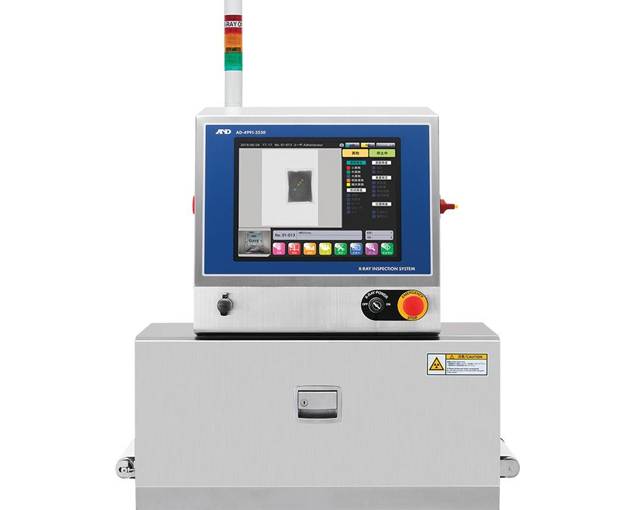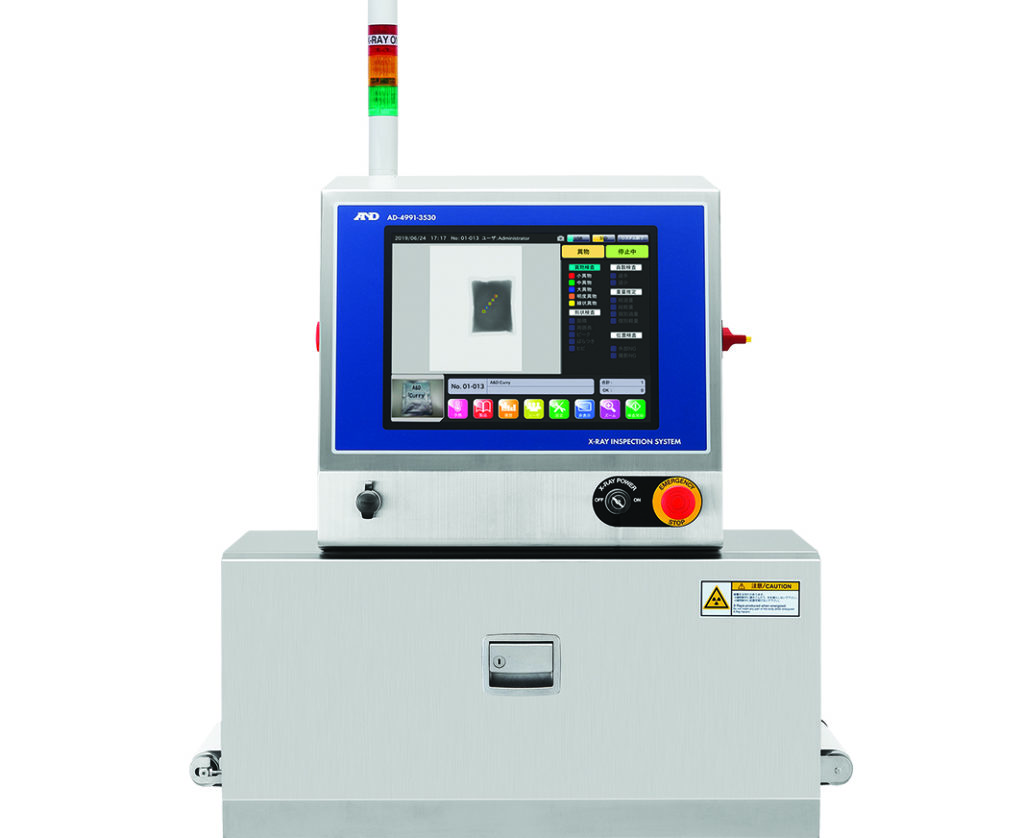 ProteX X-ray AD-4991-4530
ProteX X-ray AD-4991-4530
The increased dynamic inspection capabilities provide great confidence and increased quality control standards. Advanced inspections such as shape detection, mass estimation, piece counting and more.
 ProteX X-ray AD-4991-3530
ProteX X-ray AD-4991-3530
Advanced inspections such as shape detection, mass estimation, piece counting and more
Sanitary design complies with hygenic standards and is easily cleaned
 ProteX X-ray AD-4991-2515
ProteX X-ray AD-4991-2515
Advanced inspections such as shape detection, mass estimation, piece counting and more
Sanitary design complies with hygienic standards and is easily cleaned
 ProteX X-ray AD-4991-2510
ProteX X-ray AD-4991-2510
X-ray inspection in food packaging and pharmaceutical applications is growing exponentially because of the versatility it provides.
The increased dynamic inspection capabilities provide great confidence and increased quality control standards, which allow customers to further differentiate their brand.
X-Ray inspection systems: benefits for the food and pharmaceutical industry
X-ray inspection systems are one of the most effective ways of inspecting food and pharmaceutical products for contaminants during production. They can automatically detect a range of contaminants such as metal, plastic and bone which other detection technologies can miss.
Benefits of implementing X-ray inspection systems
- Can detect a range of contaminants in food and pharmaceutical products
- X-ray inspection for food is one of the most effective ways of detecting metal, bone, glass, stone and plastic fragments within food and pharmaceutical products.
- Detect ferrous and nonferrous contaminants in food and pharmaceutical packaging
- They can also be used to detect trace ferrous and nonferrous contaminants within the foil and metalised packaging itself.
- Check for missing items
- Additionally, they can also be used to monitor the integrity of products. Issues such as missing items and excess ingredients can be easily be detected.
Tips to select the right X-ray system
Implementing X-ray inspection into your production process is desirable for several reasons, but choosing the right food X-ray system can be challenging.
The food X ray inspection system market is complex with several different types of machines available, so you need to ensure you get the right type of machine for your production line. There are several things to think about when selecting an X-ray inspection system.
1. Generator specifications
The generator is the heart of the X-ray inspection system. A more powerful generator will allow you to produce stronger X-rays, so you need to think about the density of your products and packaging to ensure you get a machine with the right capability.
2. Scanning speed
The speed of the production line can be a key consideration. Basic systems can provide good imagery but work slowly. This may impact the overall speed of the production line. Make sure the system you choose is fast enough to cope with your existing line.
3. Licensing
Each state in Australia has different regulations regarding the installation and servicing of X-ray equipment. It is important to work with a supplier that can give you guidance on license regulations and requirements for the installation, use and maintenance of the system in your particular state.
4. System integration
To be effective, X-ray machines need to be integrated into your production process as seamlessly as possible. Always ask how easy it is to integrate the system and software with your existing production line systems.
5. Industry specialisation
The food and pharmaceutical industries have special regulatory requirements for the inspection of products. Always work with companies that specialise in X-ray inspection in your particular industry applications.
6. Manufacturer support
You should also ensure the manufacturer/supplier is capable of supporting the X-ray machine after installation as faulty or inoperable equipment can hold up the production line resulting in costly delays.
7. Lifecycle costs
Finally, you should consider the overall lifecycle costs of the system. X-ray equipment need to be regularly serviced to ensure it is working safely. Always ask what the annual maintenance costs are expected to be before agreeing to install a system.
FAQ
Why do foods need to be inspected by X-ray inspection systems?
Food products are made from natural ingredients. During the harvesting of these ingredients, foreign objects can sometimes find their way into the processing plant. X-ray inspection helps to identify such objects thereby protecting the integrity of the product.
How safe is food X-ray inspection systems for food?
Automated X-ray inspection releases small amounts of radiation which can cause some concern for food and pharmaceutical manufacturers. However, the amount of radiation released is extremely small and complies with Australian guidelines for food safety.
The amount of radiation released is significantly less than that emitted by natural sources such as: radon gas, gamma decay in rocks, cosmic radiation and background radiation from the sun.
Will workers be harmed by radiation from a food X-ray inspection?
All X-ray equipment sold in Australia must be certified to ensure the operator is not exposed to more than 0.1 millirems (mrem) of radiation per hour. Assuming a typical 40-hour workweek, workers are only exposed to a maximum of 200 mrem per year.
The International Commission on Radiological Protection states that we can safely absorb up to 5000 mrem per year.
Are there regulatory standards for food X-ray systems?
Yes, all major countries around the world have regulatory standards that ensure the safe use of radiological equipment. In Australia, radiological equipment is regulated by each state.
Why use X-Ray Inspection technology?
X-ray inspection helps food and pharmaceutical companies to safeguard the integrity of their products. This gives consumers confidence that these products are safe and helps to protect brands from the negative publicity caused by product recalls.
Why are X-ray systems used for contaminant detection in food?
Previous methods for identifying foreign objects in food relied on metal detection. While this works effectively for both ferrous and nonferrous metals, metal detectors often struggle to detect bone, glass, stone or plastic fragments. Additionally, if the packaging has some form of metal/foil, then any contaminants will be difficult to be picked up on a metal detector.
X-ray detection machines are more effective at identifying these materials. Furthermore, X-ray machines produce high-resolution scans which can be used to identify faulty products and missing components before shipping.
How does an X-ray system work?
Modern X-ray machines produce a stream of electromagnetic radiation that passes through an X-ray tube. This tube contains an anode that produces X-rays. These high-energy rays are then directed towards the product to be analysed.
Different materials absorb X-rays at different rates, soft material has a low absorption rate, while dense material has a high absorption rate. The absorption rates are detected by a sensor that uses them to build an image for analysis.
What types of contaminants can be detected in food by X-ray systems?
X-rays can detect a range of contaminants across a broad range of categories including plastic, metals, stone and bone. Machines can also be specified to detect specific contaminants and sizes. Examples include salt lumps, raw bone fragments and PTFE.
At which points in the production process should manufacturers install an X-ray system?
X-ray inspection is most effectively used in two places on the production line. They can be installed at the beginning of the production line to scan raw ingredients as they come in. This helps to identify objects picked up during harvesting.
They are then used again once production is completed to scan finished product / goods. This helps to detect contaminants introduced during the production process, and can be used to identify faults such as air bubbles and missing components.
Can X-ray inspection support my overall equipment effectiveness and increase production efficiency?
Yes, this is one of the biggest benefits of using X-ray detection. The machines can be easily integrated into your existing production line process. This allows you to benefit from the technology without making significant changes to your production process.
The speed and accuracy of the machines also help to improve production efficiency. There are fewer false reject rates than other types of inspection equipment, plus X-ray machines can be specified to match your production line speed.
Can X-ray inspection help to secure new business?
Yes, many major pharmaceutical and food manufacturers stipulate that X-ray inspection is essential in the manufacturing process of their products, while smaller brands are aware of the benefits of the technology. Installing an X-ray inspection system can help you secure new business.
Should I install an X-ray inspection or metal detection system on my production line?
X-ray detection is preferable to other methods because it’s capable of identifying more contaminants than metal detection alone. X-ray detection can also be used to detect contaminants where metal/foil packaging is used. Because of these extra benefits provided from a superior inspection system, X-ray systems are generally a lot more costly than metal detectors.
Are X-ray systems expensive to service?
The X-ray inspection machine price is only part of the cost of installing the technology. X-ray machines need to be inspected and serviced each year to ensure they continue to work safely.
The cost of an annual inspection is affordable, however. Most X-ray inspection systems manufacturers will provide you with an inspection and service plan when you install your machine.
Protect your products with ProteX X-ray equipment
A&D Inspection supplies X-ray inspection systems specifically designed for food and pharmaceutical manufacturers, which allows them to be easily integrated into most production lines.
Get in touch today for more information about our advanced ProteX X-ray equipment. We have offices in South Australia, New South Wales, Victoria and Tasmania. Or you can complete the contact form here.

